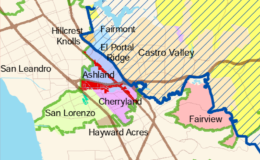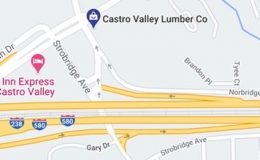Cityhood Lost: California keeps Castro Valley unincorporated, new cities struggling
- By : Michael Kusiak
- Category : Alameda County, Governance, Local Control, MAC, State of California
- Tags: alameda county, finances, Incorporation, Jurupa Valley, LAFCO, State of California, Vehicle License Fee, VLF
Back in 2012, as I passionately argued for an incorporated Castro Valley before a packed audience at the “Great Castro Valley Debate,” I had to concede that despite my dream for Castro Valley home rule, achieving municipal independence for our community was unlikely…all because of something called the “Vehicle License Fee (VLF).”
I had only just learned about the Vehicle License Fee the day of the “Great Debate” in a telephone interview with Stephen Harding, the first City Manager of the then recently-incorporated Jurupa Valley, a community of 95,000 in Riverside County.
Two days before Jurupa Valley’s July 1, 2011 incorporation, the California Legislature passed Senate Bill 89, which reallocated VLF revenue away from cities and counties to pay for law enforcement programs under fund Public Safety Realignment. With the passage of SB 89, Jurupa Valley lost “47 percent of its expected first-year revenues” the moment it incorporated, according to Harding. The legislation immediately put Jurupa Valley in fiscal crisis, despite a fiscal analysis under the old rules that demonstrated the community’s “viability.”

In August 2012, Harding declared that “The City of Jurupa Valley has the notoriety of being the newest incorporated municipality in the State of California, due to the volition of its citizens. It may also gain the notoriety of being the shortest-lived — and even the last — incorporated city in California’s 162-year history, due to the volition of the state government.”
Jurupa Valley played by the state’s rules. Before becoming a city, it formed a citizens’ incorporation committee. It analyzed its ability to fund municipal services by commissioning a fiscal feasibility study as required by state law. It successfully negotiated the cost of transitioning services with the County of Riverside. It received the recommendation of the Riverside County Local Agency Formation Commission to place the issue of incorporation on the ballot. In March 2011 it received an affirmative majority vote by its residents to become the State of California’s newest local jurisdiction. Jurupa Valley incorporated to have more direct control over its own affairs, to provide a higher level of public safety and to have a greater say in its own destiny.
In January 2014, the City Council of Jurupa Valley voted to start the process of disincorporation.
Vehicle License Fee as “start-up” funds for new cities
Unraveling the complexity of California’s system of financing governance is daunting. Revenues are collected and distributed in a very centralized manner. Transparency is lacking given the complex formulas and rules used to distribute funding back to local governments and districts.
Similar to the dissolution of redevelopment agencies and the legislation that followed to “fix” the resulting confusion from the “wind down” of redevelopment activities, SB 89 and previous changes to the VLF were enacted to address fiscal strain in how government services are funded in California. The history of the VLF and how the State of California has tinkered with it to fill holes in the state budget over the years is not easily understandable on a first or ever second read. This timeline, however, should give you a quick overview of recent legislative history of the VLF.
Historically, VLF revenues have played a critical role in financing newly incorporated cites, according to the California Planning & Development Report:
In the halcyon days of old, cities could count on state Vehicle License Fees (VLF) to help pay some of their initial costs as they were created, before they developed their own tax bases to fund services. Those funds were wiped out for new towns in 2011 when Brown had the money diverted to prison realignment via that session’s SB 89.
“The fiscal viability of new cities – the four that have incorporated since 2004 as well as any others in the future – has now been thrown into peril,” according to March 2014 summary by CaliforniaCityFinance.com. “Virtually all annexations of urbanized areas and new city incorporations have been made financially unfeasible by the loss of huge amounts of revenues that previously would have gone to these areas.”
Previous attempts to incorporate Castro Valley have failed (the 2002 vote on incorporation garnered 27.9% in favor and 72.1% against incorporation and the 1957 vote was 75% against,) but the only reason why citizens were able to vote on incorporation in first place was because our Local Area Formation Commission (LAFCo) deemed, based on an exhaustive fiscal analysis that a “City of Castro Valley” would be viable.
In a system where new cities are expected to pay “alimony” to the counties, VLF provided critical start-up funds for recently incorporated city. In the fiscal analysis for Castro Valley incorporation, VLF funds would have contributed about 26 percent of a City of Castro Valley’s general fund in 2003, decreasing to about 17 percent in 2012. SB 89 has made Castro Valley and most other unincorporated communities in California permanently fiscally unviable, leaving our communities in permanent local governance limbo as long the rules aren’t changed.
Whether or not Castro Valley wants to be incorporated in 2015 or beyond, it is unlikely that the Alameda LAFCo would deem an incorporated Castro Valley viable since the State of California has reallocated revenue generated in our community (but not for legacy cities like Oakland, Berkeley, and San Francisco). Our choice to decide our future has been taken away.
Trying to fix the problem for Jurupa Valley
Since Jurupa Valley’s incorporation, the legislature, in particular Senator Richard Roth of Riverside County, has sought to restore VLF funding to Jurupa Valley, and three other communities in Riverside County affected by SB 89 (Wildomar incorporated July 1, 2008, Menifee incorporated October 1,2008, and Eastvale incorporated October 1, 2010).
Every legislative session since 2012 has featured a bill to tackle the VLF snafu in SB 89. In the Senate, SB 1566 (2012), SB 56 (2013), SB 69 (2014), and most recently SB 25 (2015). In the Assembly, AB 1098 (2012) and AB 1521 (2014).
Last session, Roth’s SB 69 passed the Senate and Assembly, but was vetoed by Governor Jerry Brown. The Governor previously vetoed AB 1098 in 2012.
If you take a look at the Governor’s veto messages, you see a concern to maintain fiscal balance after the multi-year budget crisis that affected California from 2008-2012.
The Governor’s 2012 veto message for AB 1098 stated:
AB 1098 would reallocate vehicle license fee revenues to recently incorporated cities that annexed inhabited territory.
As drafted, this bill would undermine the 2011 Realignment formulas in a manner that would jeopardize dollars for local public safety programs, provides cities new funding beyond what existed under previous law, and would create a hole in the General Fund to the tune of $18 million. Given the current fiscal uncertainties, this is not acceptable.
The Governor’s 2014 veto message for SB 69 stated:
I am returning Senate Bill 69 without my signature.
This bill allows four cities that incorporated after January 1, 2004 and before January 1, 2012 to receive additional property tax revenue through a redistribution of Vehicle License Fee revenue.
While it is true that the state’s economy has improved markedly, and significant progress has been made in aligning revenues and expenditures, I do not believe that it would be prudent to authorize legislation that would result in long term costs to the general fund that this bill would occasion.
The ability to create new local governance structures for unincorporated communities and maintaining governance structures for communities caught in the middle of a legislative quirk is directly related to the Governor’s desire to maintain a “balanced” budget. “Local control” resides with Sacramento, which also substantially controls how revenues are collected and distributed for all governments in California (the state, counties, cities, and special districts). Local governance desires are subordinated to larger state priorities and commitments.
This session, the Senate is tackling the VLF fix once more with SB 25. In a December 2014 press release about the bill, Senator Roth stated:
This is an issue of fairness and equity. Due to state budget cuts, our four newest cities lost the start-up monies the state previously provided all new cities to get started. As a result, Jurupa Valley, through no fault of their own, faces the unfortunate reality of losing their city.
How can Castro Valley achieve greater home rule?
As Supervisor Nate Miley often likes to point out “reasonable people can disagree.” But whether or not you think Castro Valley should be incorporated, the fact that our right to seek incorporation has been effectively taken away makes me mad and should make you mad too. It points to California’s non-transparent, dysfunctional and imbalanced system of funding local government.
Castro Valley Matters has identified only one community that is actively considering incorporation since SB 89 tinkered with VLF in 2011. The proposed “Olympic Valley” doesn’t need VLF to incorporate – it’s really, really rich. The town has a scant 538 registered voters, and is home to Squaw Valley Ski Resort, one of the largest ski resorts in the country -a huge revenue generator for the area [As a side note, the “Myths and Truths” section of the Incorporate Olympic Valley homepage does an excellent job debunking the untruths about incorporation that were circulated in the 2002 Castro Valley incorporation campaign]. I wish the proponents of Olympic Valley incorporation success in their efforts.
I plan to be in Sacramento this Wednesday, April 8, 2015, when the Senate Governance and Finance Committee discusses SB 25, because the fate of this legislation affects all unincorporated communities that might want incorporation in the future. I support the right of Jurupa Valley and its citizens to form their own local government. I want that right for my community and all California communities. I respectfully ask our Governor to stop vetoing this legislation.
Even if Castro Valley were to organize a new incorporation campaign, it is highly likely that our LAFCO, the independent agency that determines the fiscal viability of proposed new local government agencies in each California county would pass a resolution supporting the “viability” of a “City of Castro Valley.” Given the cost for an effective incorporation campaign, the odds against getting LAFCO approval should give even the most ardent incorporation proponent pause.
If we weren’t trapped in an archaic local governance finance system that itself is layer of band-aids on top of another, Castro Valley could seek incorporation. SB 89 was one band-aid, the pending SB 25 is another band-aid. But the larger problem of state finance system that leaves unincorporated communities in local governance limbo goes unaddressed even if Jurupa Valley gets its VLF. As such, I respectfully ask our legislators Senator Bob Wieckowski and Assemblymember Bill Quirk to make local governance reform in unincorporated communities a priority in their legislative agendas.
Even if the possibility for incorporation is not currently feasible under California’s finance rules, we should seek still meaningful governance reform for Castro Valley. Options that we could consider until Castro Valley is moved to the “fiscally viable” bucket, include:
- An elected Municipal Advisory Council (MAC) or a similar entity with greater powers over planning, models that have been discussed at Supervisor Miley’s Eden Area Livability Initiative (EALI).
- Community Service District, similar to a proposal making its way through the Assembly now.
- An “unincorporated town,” similar to a model currently used in Nevada.
All of these options require our local leaders in Alameda County and Sacramento to push back on vested interests and a system that does not naturally account for the needs of unincorporated communities. As Senator Roth continues to do every session for Jurupa Valley, we need leadership that will seek solutions for Castro Valley even if it is not consistent with the Governor’s grand plan for the state budget and even if it challenges a status quo that allocates revenues and the power to govern away from our community.



Great assessment of the current situation. In Castro Valley. The refusal of the Board of Supervisors to pursue an elected MAC remind me of Hong Kong where the Chinese Government refuses the city the right to elect its own representative. What is Scott Haggerty afraid of – improved over site and representation? I would like to see in detail where Castro Valley tax dollars have gone over the years, and have a greater say on how they’re used in the future. When someone’s afraid of change, it causes me concern.